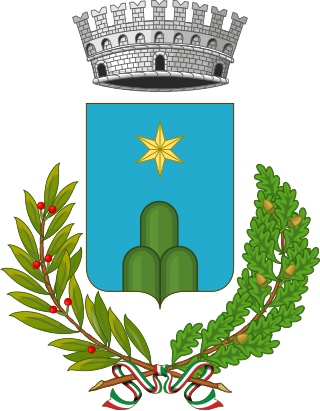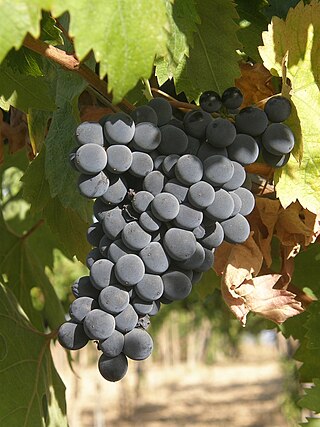
Bianchello del Metauro is a denominazione di origine controllata wine made in the province of Pesaro and Urbino, in the region of Marche, Italy. The DOC was created in 1969.

Bianchello del Metauro is a denominazione di origine controllata wine made in the province of Pesaro and Urbino, in the region of Marche, Italy. The DOC was created in 1969.
The region lies on the eastern coast of Italy, close to Pesaro, and encompassing the towns of Fano and Senigallia. The wine region completely lies within two larger DOCs: Colli Pesaresi and Falerio dei Colli Ascolani, and shares its southern part with the Lacrima di Morro d´Alba DOC.
The wine region consists of hills running west to east along the Metauro River, in northern Marche. The soil is mostly sandy clay. [1]
According to legend, the Roman army defeated a Carthaginian force led by Hannibal's brother, Hasdrubal, due to the vast consumption of Bianchello wine prior to the battle.
Bianchello del Metauro is unique because it is made almost completely with the Bianchello (also known as Biancame or Biancuccio) grape. According to the regulations for the DOC, Bianchello must consist of at least 95% of the blend.

Chianti is an Italian red wine produced in the Chianti region of central Tuscany, principally from the Sangiovese grape. It was historically associated with a squat bottle enclosed in a straw basket, called a fiasco. However, the fiasco is now only used by a few makers of the wine; most Chianti is bottled in more standard-shaped wine bottles. In the latter nineteenth century, Baron Bettino Ricasoli helped establish Sangiovese as the blend's dominant grape variety, creating the blueprint for today's Chianti wines.

Fano is a town and comune of the province of Pesaro and Urbino in the Marche region of Italy. It is a beach resort 12 kilometres southeast of Pesaro, located where the Via Flaminia reaches the Adriatic Sea. It is the third city in the region by population after Ancona and Pesaro.

Verdicchio is a white Italian wine grape variety grown primarily in the Marche region of central Italy. The name Verdicchio derives from verde and refers to the slight green/yellow hue that wines made from the grape can have.

The Metauro is a river in the Marche region of central Italy. It rises in the Apennine Mountains and runs east for 110 kilometres (68 mi) or 121 kilometres (75 mi) if the Meta is included as its uppermost reach.

Saltara is a frazione of the comune of Colli al Metauro in the province of Pesaro e Urbino, Marche, central Italy. It is on a 120-metre (390 ft) hill overlooking the lower Metauro valley. It was a separate comune until 1 January 2017.

Sant'Angelo in Vado is a comune (municipality) in the province of Pesaro and Urbino, in the Italian region of Marche.

Serrungarina is a frazione of the comune of Colli al Metauro in the Province of Pesaro e Urbino in the Italian region Marche, located about 50 kilometres (31 mi) northwest of Ancona and about 20 kilometres (12 mi) south of Pesaro. It was a separate commune until 1 January 2017.

Montepulciano is a red Italian wine grape variety that is most noted for being the primary grape behind the DOCG wines Colline Teramane Montepulciano d'Abruzzo and Offida Rosso; and the DOC wines Montepulciano d'Abruzzo, Rosso Conero, and Rosso Piceno Superiore.
The Colli Orientali del Friuli is a Denominazione di origine controllata (DOC) located in the Italian wine region of Friuli Venezia Giulia. The region is located in the province of Udine and is sub-divided into three main sections; Ramandolo in the north, Cialla and Corno di Rosazzo. The climate and soil is very similar to the neighboring DOC of Collio Goriziano and the two region share many winemaking similarities as well. The main distinction between the Colli Orientali del Friuli and Collio Goriziano lie in the increased red and dessert wine production of the Colli Orientali del Friuli. The region also includes within its boundaries the three Denominazione di origine controllata e garantita (DOCG) of the Friuli Venezia Giulia Ramandolo and the two passito wine DOCGs of Colli Orientali del Friuli Picolit and Colli Orientali del Friuli Picolit-Cialla.

Bombino bianco is a white Italian wine grape variety planted primarily along Italy's Adriatic coast line, most notably in Apulia. The vine is prone to high yields and often produces neutral flavor wines. The grape is known under many synonyms throughout Italy including Debit and Pagadebit, names which came from the grape's reputation for being a high yielding and reliable crop for vineyard owners to grow that would assure them that on each vintage they could pay off their debts.
Biancame is a white Italian wine grape variety that is grown in the Marche and Emilia-Romagna regions of Italy. Here it is an important component in the Denominazione di origine controllata (DOC) wines of Bianchello del Metauro and Colli di Rimini.

Pecorino is a white Italian wine grape variety that grows in the Marche, Abruzzo, Tuscany, Umbria and Lazio regions of Italy. Ampelographers believe that the grape is likely native to Marche, where the soil destined for this cultivation increases every year. This grape variety is used to produce the DOCG wines, like the Offida Pecorino DOCG, and the DOC wines, like the Falerio dei Colli Ascolani, the Colli Maceratesi and the Falerio dei Colli Ascolani.
Falerio dei Colli Ascolani is a denominazione di origine controllata white wine made in the Italian region of Marche. The DOC was created in 1975.
Colli Maceratesi is a denominazione di origine controllata wine made in the province of Macerata, in the Italian region of Marche. The DOC was created in 1975, and allows white and red wines.

Abruzzo is an Italian wine region located in the mountainous central Italian region of Abruzzo, along the Adriatic Sea. It is bordered by the Molise wine region to the south, Marche to the north and Lazio to the west. Abruzzo's rugged terrain, 65% of which is mountainous, help to isolate the region from the winemaking influence of the ancient Romans and Etruscans in Tuscany, but the area has had a long history of wine production.

Montefalco wine is a style of Italian wine made in Umbria, and awarded Denominazione di origine controllata (DOC) status in 1979.
Albanella is a white Italian wine grape variety that is grown in the Marche region where it is a primary component in the white Denominazione di Origine Controllata (DOC) wines of Colli Pesaresi. The grape is often confused with the similarly named Sicilian wine grape Albanello and was long thought to be identical to the Tuscan wine grape Trebbiano but has established through DNA analysis to be its own distinct variety.

Colli all Metauro is a comune (municipality) in the Province of Pesaro e Urbino in the Italian region Marche. It was created on 1 January 2017 after the merger of the comuni of Montemaggiore al Metauro, Saltara and Serrungarina. The communal seat is at Calcinelli, its largest frazione.

Sant'Andrea di Suasa is a hamlet of the municipality of Mondavio in the province of Pesaro-Urbino, Italy. The castle-village sits 265 metres above sea level, 23 km from the Adriatic coast and develops along the crest of a large hill to the left of the Cesano river. It is characterized by the mighty wall circuit still intact with a single arch entrance.